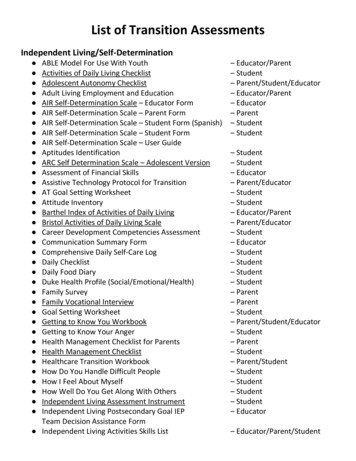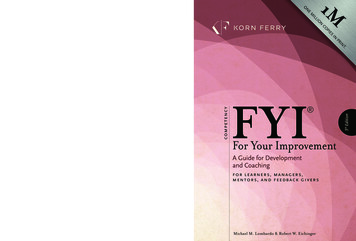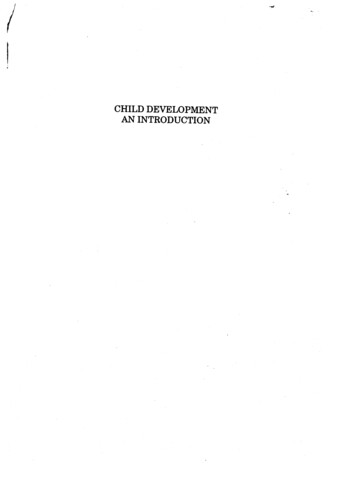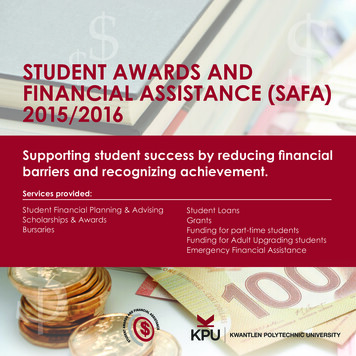
Transcription
Advances in Engineering Research, volume 209International Joint Conference on Science and Engineering 2021 (IJCSE 2021)The Development of Student-cantered Learning ModelTextbook to Teach Mathematics:A Preliminary ResearchPradnyo Wijayanti1 Nina R. Prihartiwi2,* Mega T. Budiarto3 Ismail4 Ika Kurniasari51,2,3,4,5Department of Mathematics, Universitas Negeri Surabaya, IndonesiaCorresponding author. Email: ninaprihartiwi@unesa.ac.id*ABSTRACTThis research is exploring the need of development of student-cantered learning model textbook to teach mathematicsthrough Innovative Learning II course. This course is compulsory course for students of mathematics education studyprogram. The paper focuses on the preliminary research of the three main phases in design research by Plomp thatconsists of needs and context analysis, review of literature, and development of a conceptual or theorical framework forthe study. Referring to the curriculum of the mathematics education study program, Innovative Learning II course hasbeen going on for several years, but the learning resources used by students from several separated sources and havenot adapted to the latest yet. Also from questionnaire, about half of the students don’t have textbook to assist theirlearning. The other half who had already have, felt that they need more features to assist their learning such as moreexplanation about discovery learning and inquiry, and printed textbook in Bahasa Indonesia. The development is one ofstep to facilitate students, so that the goal of constructing a pedagogical scientific foundation on student-centeredlearning models can be achieved since the availability of complete textbooks will make it easier for students to studythese subjects. This textbook is expected can give clear explanation about models using student-centered approach byserving complete materials (from characteristics, the objectives, theorical underpinning, and assessment), alsoaccompanied by sample of its application with valid, practical, and efficient criteria.Keywords: Development of textbook, Student-centered learning, Mathematics.1. INTRODUCTIONRogers defined student-cantered learning (SCL) as anapproach to learning, in which students have option, notonly what to study but also how and why that topic mightbe of interest [1]. SCL is based on constructivism, whichis built on the idea that students must construct andreconstruct knowledge to learn effectively, with learningbeing most effective when the students have experiencesin constructing a meaningful product [2]. This approachis different from teacher-cantered learning (TCL) whichis common widely applied in school, where teacher actsas a cesnter of learning and transfer knowledge tostudents. In SCL, teacher acts as facilitator and motivatorrather than the only one learning sources [3].In applying SCL, students need individualization,interaction, and integration [1]. Individualization isneeded to ensure that students are encouraged to createtheir own activities and select their own authenticmaterials, then students interact through team learningand by teaching each other. Moffet & Wagner said thatstudents integrate what they have learned with priorlearning and construct new meaning in the learningprocess [1]. There are ten overlapping elements in SCL,i.e., students and teacher as co-learners, student-studentinteraction, learner autonomy, focus on meaning,curricular integration, diversity, thinking skills,alternative assessment, learning climate, and motivation[4].SCL in classroom gives positive impacts, not only inlearning achievement but also social skills, speaking,listening, logic and solving problems with experientialinteraction [5]. SCL is similar to transformative learningthat contemplates a qualitative change process in studentsas continuing transformation that focuses on students’enhancement and empowerment, develops their criticalability [2].Copyright 2021 The Authors. Published by Atlantis Press International B.V.This is an open access article distributed under the CC BY-NC 4.0 license 9
Advances in Engineering Research, volume 209SCL can encourage deeper learning, so that increasestudents’ motivation to learn, and since in SCL studentsmust engage with the course material and are in controlof their learning, it creates independence andresponsibility in their own learning [2]. SCL reflects thereality of how students learn regardless of how teacherteach, also SCL focuses on lifelong learning, for instanceon thinking skills, on diversity, and on student–studentinteraction, potentially empower students to shape betterfuture [4]. Students who were taught with SCL approachagreed that the group work gave them motivation to learnmathematics and built their confidence in doingmathematics [6]. SCL in mathematics also exposesstudents to the application of concepts in and out ofclassroom, gives students freedom to ask or get answerfrom other members, lets students talk how to solveproblems with others, and gives higher confidence tolearn following lessons [7]. Therefore, SCL is suitablewhen applied in mathematics classroom.Some learning models that are compatible with SCLin mathematics classroom are cooperative learning,problem-based learning, discovery learning, and projectbased learning.1.1. Cooperative LearningCooperative learning is a set of instructionalstrategies in which students work in mixed-ability groupsto reach specific cognitive and social developmentobjectives [8]. In addition to diversity of abilities, grouparrangement, if possible, also varies in ethnicity, gender,background, and culture. This is because cooperativelearning is designed and implemented with the aim ofdeveloping social strategies and social attitudes instudents, as well as improving social relationships withinand between groups [9] and developing mutual respectamong students [10]. There are five main elements ofcooperative learning: positive interdependence, face-toface, individual accountability, social skills, and groupprocessing [11]. Mathematics education offers specificopportunities for cooperative learning that makescooperative learning in mathematics different from otherdomains, such as languages and world orientation, whichthe content of mathematics allows for specific models ofcooperative learning in order to accommodate individualdifferences between students and mathematical problemscan be situated in real-life contexts and designed in sucha way that solutions can be reached along different routesand at different levels [9]. Other than the characteristicsabove, cooperative learning needs students to constructtheir knowledge by themselves [10]. This characteristicis suitable for mathematics learning to becomemeaningful for students, for example cooperativelearning can be applied to teach triangle, quadrilateral,natural numbers, whole numbers concepts etc.1.2. Problem-based Learning (PBL)PBL is a learning approach that challenges studentsto learn through problem solving in which done bycooperatively in small groups [12]. Rather than lookingfor one single right answer, students interpret problem,collect needed information, identify possible solution,evaluate alternatives, and present conclusion as of PBLfocuses on learning experiences through investigationand problem-solving [13]. Therefore, when PBL isapplied in mathematics classroom, it enhances students’mathematical critical thinking ability [12] since PBLserves problems to be solved by students that activatestudents’ thinking. Thus, PBL is compatible for learningthat has objective is applying mathematics concepts forproblem-solving [10].1.3. Discovery Learning (DL)DL organizes learning in such a way that studentsacquire new knowledge without direct teaching, withsome or all of it discovered by the students themselves[14]. This model emphasizes the importance of helpingstudents understand the structure or key ideas of adiscipline, the need for active student involvement in thelearning process, and a belief that true learning comesthrough personal discovery [10]. DL evokes students’curiosity, motivates them to work until they find answer,and since they must analyse and manipulate information,students also learn independent problem-solving andcritical-thinking skills [15]. DL also serves learningprocess that gives an emphasis on the students optimallyso that the objective in mathematics education can beachieved, for example in learning geometry [16].1.4. Project-based Learning (PjBL)PjBL is typically considered an approach to s or challenges through an extended inquiryprocess [17]. The characteristics of PjBL are developingstudents’ thinking skill, enabling creativity, encouragingstudent to collaborate, and directing students to accessinformation by themselves and to demonstrate theinformation [18]. Furthermore, Park explained thecharacteristics of PjBL [13] are (1) using real worldproblem, (2) problem is used to directing learning; not forassessing skill, (3) using ill-structured problem, (4)students are given responsibility progressively, so thattheir independence increase, and (5) resultingindependent students, life-long learners. The example ofPjBL in mathematics classroom is shown in statistics,especially central tendency [19].From the description above, it is clear that SCL isbeneficial for students. But SCL not only give benefits to480
Advances in Engineering Research, volume 209students, but also teacher in connection to pre-servicestudents. Attard, Iorio, Geven & Santa proposed that SCLgives a more interesting role for teacher, providessolutions to tackling massification and diversity, givespositive impact on working conditions, allowscontinuous self-improvements, increases learnermotivation and engagement, and offers professionaldevelopment for academia [2]. Willower, Eidell & Hoyin [20] said that the transition from TCL to SCLclassroom management also gives transition in teacher’sbelief, from likely to be highly controlling, employingpunitive sanctions, moralistic perceptions, highlyimpersonal relationships with students, attitude ofgeneral mistrust and a major focus on the maintenance oforder to be more humanistic, likely to maintain aclassroom climate that allows active interaction andcommunication, mutual respect, positive attitudes, andflexibility of rules, as well as student self-discipline, selfdetermination and independence are fostered.Learning models using student-centered approach arestudied in Innovative Learning II. This course is acontinuation of the Innovative Learning I course whichstudies TCL models. The course is compulsory for allstudents of mathematics education study program.Referring to the curriculum of the mathematics educationstudy program, Innovative Learning course has beengoing on for several years, but the learning resourcesused by students from several separated sources and havenot adapted to the latest yet. Thus, it is necessary todevelop Innovative Learning II textbook to assiststudents in mastering theory and then applying it inlearning mathematics.The development of Innovative Learning II textbookcontaining student-centered learning models will greatlyassist students in the learning process of these subjects.The use of textbook in learning can improvemathematical problem-solving ability [21] and improvelearning outcomes [22], also students gave positiveresponses to the satisfaction and usefulness [3].Therefore, the development is one of step to facilitatestudents, so that the goal of constructing a pedagogicalscientific foundation on student-centered learningmodels can be achieved since the availability of completetextbooks will make it easier for students to study thesesubjects.2. METHODSThis study is using design research by Plomp thatconsists of three stages: preliminary research,prototyping phase, and assessment phase [23]. Thediscussion is restricted only in preliminary phase withactivity description as explain in Table 1 as follows.Table 1. Preliminary Research in This PaperPhaseDetailsNeeds andcontextanalysisPreliminaryresearchReview ofliteratureDevelopment of aconceptualor theoricalframeworkforthestudyActivity DescriptionThe initial review of theneed of textbook forInnovative Learning IIcontaining SCL modelsbased on eobjectives and contentsof Innovative Learning IIcourse.Analysing theories andconcept of the models,assessments,andexamplesoftheirapplications in learningmathematics.Designing a conceptualframework and theoricalframeworkforthedevelopment.3. RESULTS AND DISCUSSION3.1 The Need and Context AnalysisInnovative learning is one of the main assets forteachers to carry out their professional tasks. One of thecharacteristics of innovative learning in the 21st centuryis SCL. Innovative Learning II course which containslearning models using student-centered approach is oneof the compulsory courses for students of themathematics education study program. Based onteachers’ experiences, Innovative Learning course hasbeen going on for several years, but the learningresources used by students from several separatedsources and have not adapted to the latest yet.Besides, from seventy-one questionnaire responsesfrom ninety-two students of mathematics educationprogram academic year 2019 we got that majority ofstudents (64.8%) thought that Innovative Learning IIcourse is easy to understand. But, they found difficultiesin their learning, such as (1) PBL is difficult since not allmaterials in mathematics are suitable for this model; (2)PBL needs authentic, complex, and contextual problemsso that students needed more effort in creating them; (3)creating scheme of DL model is tough; (4) givingstimulation in DL model is not easy; (5) feeling puzzledin devising a plan in DL model that material can beunderstood well; (6) innovating learning, because whenin class there will be definitely a different condition thanas planned; (7) feeling confused in searching material orcreating problem of inquiry (student felt that suitableproblem for inquiry is limited); (8) inquiry need to be481
Advances in Engineering Research, volume 209discussed in depth; (9) having difficulty in distinguishingcooperative learning and DL; (10) hardship in gatheringreferences for presentation and availability of validreferences is limited. It implied the material is hard tounderstand; (11) even though every model has certaincharacteristic, choosing the right model for a certainsubject and class condition for heterogenous class iscomplicated; (12) also, since every model is havingsimilarity of each other, if students don’t understand well,they will face puzzling situation in creating students’worksheet.From the questionnaire, 73.2% felt that referenceswere given by the teacher had helped them to understandthe course. 52.1% didn’t have textbook for InnovativeLearning II and 82.9% of them felt like they needtextbook to support their learning. The reasons studentsfelt need textbook of Innovative Learning are (1) oftenstudent’s notes were not complete so they need otherreference, (2) textbook facilitates learning become easierand structured, (3) from references they searched; theyfound different syntax, (4) as reference to enhanceknowledge and to confirm information from othersources, also to complete material from recommendedreference, (5) as guide to learn before the teacher explainin class; so that students understand more, (6) sometimesit is difficult to find suitable reference and internetsources sometimes are not valid, and (7) easier to learnfrom printed book rather than e-book.Other 47.9% who already have book used inInnovative Learning, told the way the book help studentsto understand the course i.e., (1) the book gives detail andclear explanation of definition, characteristics, andsyntax so it helped students to understand a learningmodel but, sometimes one of the components is notdescribed so students need other source; (2) not onlycontains syntax, but also classroom management and theassessment; (3) the contents of the book is complete,except DL and inquiry; (4) students prefer learning usingprinted textbook rather than power points or pdf file,since student can underline important or not yet knowninformation then ask it when presentation time; and (5)need more time to understand material served in Englishand there is latest edition of the book. From thisdescription although some students already have book tosupport Innovative Learning II course, they need morefeatures to assist their learning such as more explanationabout DL and inquiry and printed textbook in BahasaIndonesia. Therefore, it is necessary to developInnovative Learning II textbook to assist students inmastering theory and then applying it in learningmathematics. By considering the benefits of books that isbeing used by students, the development of the textbookwill include it as reference to enrich the textbook ofInnovative Learning II.Based on the questionnaire responses above, somefeatures that may help prospective mathematics teacherto design learning that support student-centered approachare providing tips or step-by-step in shifting mathematicsclassroom from TCL to SCL as described in [10] andserving samples of group task that can be applied inlearning process. Terwel also gave suggestion indesigning assignment based on philosophy ofmathematics education, such as (1) starting point shouldbe based on students’ present experience and priorknowledge, (2) from the point towards the concept,structures, and methods in mathematics, (3) utilize richcontexts from real life situations and move forward tomathematical contexts, (4) design ‘multi-abilityassignments’ that allow students from different levels toparticipate, and (5) assignments should be specialdesigned for learning in cooperative groups [9].The curriculum of the mathematics education studyprogram explains the description of the InnovativeLearning II course, i.e., studying the theoreticalunderpinning, stages, classroom management, andevaluation in cooperative learning models, scientificapproach-oriented learning such as: problem-basedlearning, inquiry-discovery learning, and contextuallearning accompanied by its implementation in learningthrough individual and group assignments withdiscussion and reflection. The objectives of the course arestudents be able to demonstrate theorical underpinning,syntax, classroom management, and its assessment ofcooperative learning, scientific-oriented approach, suchas PBL, inquiry-discovery, and contextual learning indesigning, implementing, and evaluating mathematicslearning; and students be able to design, implement, alsoevaluate learning process and cooperative learning,scientific-oriented approach, such as PBL, inquirydiscovery, and contextual learning materials usinginformation and communication technology (ICT).Before the students can program Innovative Learning II,the have to take Innovative Learning I as prerequisite.Innovative Learning I discusses learning theories,theories about learning strategies, indicators, lesson plan,and supporting instruments. These materials then will beused in Innovative Learning II as students design,demonstrate, and evaluate learning process usinglearning models that compatible with SCL.3.2 Review of LiteratureIn this review of literature, some literatures are basedon references in semester learning plan and is added withsome references that support the development ofInnovative Learning II textbook. Furthermore, somereferences that will be used to develop the textbook areshown in the Table 2.482
Advances in Engineering Research, volume 209Table 2. References that will be used to develop thetextbookReferencesLearning to Teachby Arends(2012/2015)EducationalPsychology,Windows onClassrooms by PEggen & DKauchak (2016)EducationalPsychology,Theory andPractice by R ESlavin (2017)Project-BasedLearning (PBL) InPractise:Active Teachers’Views of Its’Advantages andChallenges by M.Aksela dan O.Haatainen (2019)Project-BasedLearning byStivers (2010)The Seven Stepsof Project BasedLearning Model toEnhanceProductiveCompetences ofVocationalStudents byNizwardi (2017)Materi PelatihanGuruImplementasiKurikulum 2013Kemendikbud(2014)CooperativeLearningPBLDL PjBL 4. CONCLUSIONBased on the preliminary research, it is necessary todevelop Innovative Learning II textbook since theresources using now is separated and outdated. Also fromquestionnaire, about half of the students don’t havetextbook to assist their learning. The other half who hadalready have, felt that they need more features to assisttheir learning such as more explanation about DL andinquiry, and printed textbook in Bahasa Indonesia. Thistextbook is expected can give clear explanation aboutmodels using SCL approach by serving completematerial (from characteristics, the objectives, theoricalunderpinning, and assessment), also accompanied bysample of its application with valid, practical, andefficient criteria.AUTHORS’ CONTRIBUTIONS All authors discussed the research design. PradnyoWijayanti: data analysis, reviewing and editing themanuscript. Nina Rinda Prihartiwi: data analysis,drafting manuscript. Mega Teguh Budiarto: reviewingand editing the manuscript. Ismail: reviewing and editingthe manuscript. Ika kurniasari: drafting the manuscript,proofreading.ACKNOWLEDGMENTS This research is supported and funded by UniversitasNegeri Surabaya.REFERENCES Besides using the references above, we will userelevant articles to support the development to make thetextbook more comprehensive.3.3 Development of A Conceptual or TheoricalFramework for the StudyThis textbook that will be developed in the researchare materials of each learning model, i.e., thecharacteristics, the objectives, theorical underpinning,management of learning which includes planning andimplementation, and its assessment, accompanied bysample of its application in learning mathematics so thatstudents will easily apply it to teach mathematics ofcooperative learning, PBL, DL, and PjBL with valid,practical, and efficient criteria.[1] TEAL, TEAL Center Fact Sheet No. 6: StudentCentered Learning USA, 2010[2] A. Attard, E. Di Iorio, K. Geven, R. Santa, StudentCentred Learning Toolkit for Students, Staff, andHigher Education Institutions, Laserline, 2010.[3] Sujinah,ResponsMahasiswaTerhadapPembelajaran Berbasis SCL dengan Bahan AjarWeb Centric Course Berbantuan Aplikasi andanMenggembirakan(TheProgressive & Fun Education Seminar) ke-2, 2017.[4] J.M. Jacobs, W. A. Renandya, M. Power, Simple,Powerful Strategies for Student Centered Learning,Springer International Publishing, 2016.[5] M. H., Asoodeh M, M. B. Asoodeh, & M. Zarepour,The Impact of Student-centered learning onAcademic Achievement and Social Skills, Procedia- Social and Behavioral Sciences, 46 (2012), 560 5.160483
Advances in Engineering Research, volume 209[6] S. Krishnan, Student-centered learning in a first yearundergraduate course. International Journal ofLearning,TeachingandEducationalResearch, 11(2), (2015), 88 – 95. /view/353[7] S. F. H. S., Zain, F. E. M. Rasidi, I. I. Z. ctivism in The Classroom, Journal ofInternational Education Research (JIER), er.v8i4.7277[8] P. D. Eggen, D. P. Kauchak, EducationalPsychology, Windows on Classrooms TenthEdition, Pearson, 2016.[9] J. Terwel, Cooperative learning and mathematicseducation: A happy marriage. In Paper presented atthe OECD/France workshop, 2011 (23) 24, 0] R. I. Arends, Learning to Teach Tenth Edition,Mcgraw-Hill Education, 2015.[11] D. W. Johnson, R. T. Johnson, Cooperativelearning, I congreso internacional InnovaciónEducación. Zaragoza, (2017) 22-23.[12] R. Widyatiningtyas, Y. S. Kusumah,, U. Sumarmo,J. Sabandar, The Impact of Problem-Based LearningApproach to Senior High School Students'Mathematics Critical Thinking Ability. IndonesianMathematical Society Journal on files.eric.ed.gov/fulltext/EJ1079642.pdf[13] Y. K. Sahid, Mathematics problem solving andproblem based learning for joyful learning inprimary mathematics instruction, Department ofMathematicsEducation,YogyakartaStateUniversity, 2011.[17] H. Lattimer, R. Riordan, Project-based learningengages students in meaningful work: Students atHigh Tech Middle engage in project-based learning.Middle School Journal, 43(2), (2011) 18-23. [18] C. L. Chiang, H. Lee, H., The effect of project-basedlearning on learning motivation and problemsolving ability of vocational high school students,International Journal of Information and EducationTechnology, 6(9), (2016) 709-712. URL:http://www.ijiet.org/vol6/779-EP00028.pdf[19] Stivers, Project Based Learning, 2010. URL:https://www.fsmilitary.org/pdf/Project Based Learning.pdf[20] T. Garrett, Student-centered and teacher-centeredclassroom management: A case study of threeelementary teachers. The Journal of tor.org/stable/23869529[21] R. L. Nahak, V. R. Bulu, Efektivitas modelpembelajaran inkuiri terbimbing berbantu lembarkerja siswa berbasis saintifik terhadap hasil belajarsiswa. Jurnal Kependidikan: Jurnal Hasil Penelitiandan Kajian Kepustakaan di Bidang Pendidikan,Pengajaran dan Pembelajaran, 6(2), (2020) 230-237.DOI: https://doi.org/10.33394/jk.v6i2.2369[22] A. Agustina, M. Isnaini, R. S. Nery, PengembanganBahan Ajar Matematika Menggunakan EdmodoPada Materi Fungsi, Jurnal Pendidikan MatematikaRAFA, .id/index.php/jpmrafa/article/view/1244[23] T. Plomp, N. Nieveen, An introduction toeducational design research. In Proceedings of theseminar conducted at the East China NormalUniversity, Shanghai (PR China) 23, 2007.[14] D. Putriani, C. Rahayu, The effect of discoverylearning model using sunflowers in circles onmathematics learning outcomes. InternationalJournal of Trends in Mathematics .org/10.33122/ijtmer.v1i1.26[15] R. E. Slavin, Educational Psychology Theory andPractice Twelfth Edition, Pearson Education Inc,2018.[16] A. In'am, S. Hajar, Learning Geometry throughDiscovery Learning Using a Scientific Approach.International Journal of Instruction, 10(1), 7.1014a484
The Development of Student-cantered Learning Model Textbook to Teach Mathematics: A Preliminary Research Pradnyo Wijayanti1 Nina R. Prihartiwi2,* Mega T. Budiarto3 Ismail4 Ika Kurniasari5 1,2,3,4,5Department of Mathematics, Universitas Negeri Surabaya, Indonesi










